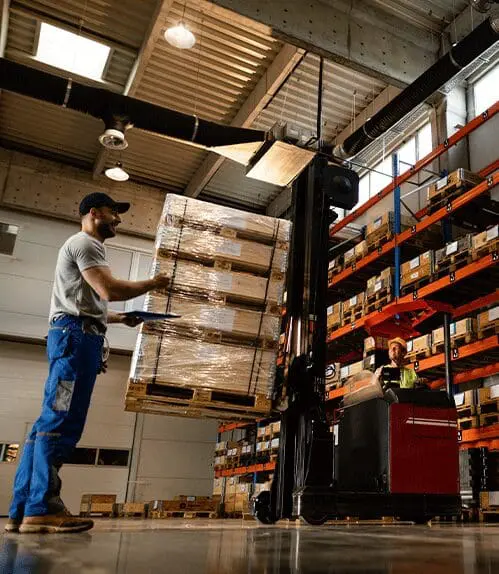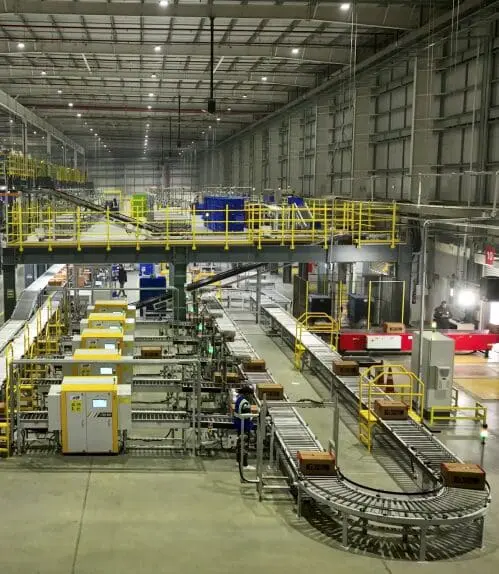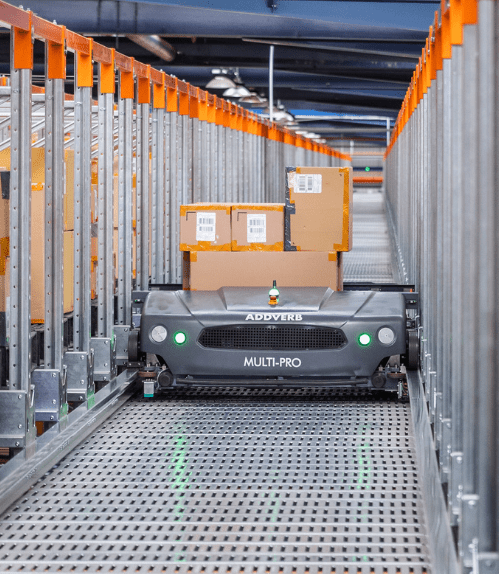Table of Contents
Autonomous Mobile Robots (AMRs) have become a cornerstone of modern supply chain operations. Amid fluctuating order volumes and evolving safety protocols, businesses are increasingly turning to warehouse automation to streamline their warehouse processes.
AMRs offer a dynamic solution, seamlessly interacting with human workers while ensuring stability and precise obstacle detection. By integrating robots into their facilities, companies can enhance agility and resilience, gaining a competitive edge in today’s rapidly changing market.
Let’s explore the transformative impact of AMRs on warehouse automation.
What are Autonomous Mobile Robots?
These little robots are made to move around in warehouse settings on their own and carry out operations including order picking, inventory control, and product transportation for effective material movement. They can interact with human operators and readily integrate with current systems, increasing total efficiency.
Addverb’s Autonomous Mobile Robot Dynamo, driving seamless operations and boosting productivity.
When Should an AMR be Deployed?
- Operational Efficiency
When there are labor shortages, high labor costs, or a need for increased productivity and efficiency.
- Task Suitability
Ideal for repetitive, hazardous, or high-precision tasks that don’t require complex decision-making.
- Technological Readiness
Ensure mature technology, seamless integration with existing systems, and available infrastructure like wireless networks and charging stations.
- Financial Considerations
Have a sufficient budget for initial costs and maintenance. Ensure a positive return on investment (ROI).
- Regulatory Compliance
Meet safety regulations and data privacy laws for the deployment environment.
- Scalability and Flexibility
Deploy when scaling operations quickly is needed without a proportional increase in human labor, and when flexibility to adapt to workflow changes is required.
- Strategic Goals
Align with long-term goals like digital transformation, innovation, competitiveness, and sustainability initiatives.
- Industry Applications
Useful in manufacturing, warehousing, healthcare, retail, and agriculture for tasks like material handling, inventory management, and delivery.
Explore our other blogs for in-depth insights on robotics and warehouse automation.
Implementation of AMR in Your Facility

How Addverb is Driving the Transformation with AMRs
Efficient Material Handling
Autonomous Mobile Robots automate material transport, reducing manual labor and errors while accelerating operations.
Optimized Warehouse Operations
AMRs navigate warehouses autonomously, adapting to layouts, avoiding obstacles, and optimizing routes for swift goods movement.
Operational Efficiency
Integration of AMR streamlines workflows, ensuring round-the-clock operations and minimizing downtime.
Flexible Deployment
Autonomous Mobile Robots are adaptable to diverse settings, easily integrating with existing infrastructure for tailored solutions.
Safety and Reliability
Equipped with advanced sensors, AMRs prioritize safety by detecting and avoiding obstacles, ensuring consistent performance even in demanding environments.
Scalability and Adaptability
Mobile robots are scalable solutions that can grow with businesses, accommodating changing needs and market demands.
Integration with Industry 4.0
AMRs facilitate connectivity and data exchange within manufacturing ecosystems, enabling real-time monitoring, optimization, and decision-making.
Conclusion
AMRs significantly enhance warehouse automation by improving efficiency, accuracy, and safety. By automating repetitive tasks, these robots reduce operational costs and increase flexibility. As technology advances, Mobile robots will become even more integral to optimizing supply chain processes and maintaining competitive edge in the logistics industry.
FAQ
How do AMRs enhance warehouse efficiency?
Streamline operations by automating repetitive tasks, reducing human error, and optimizing workflows, increasing productivity and efficiency.
Are AMR safe to use in warehouses?
They are equipped with advanced sensors and safety features to detect obstacles and avoid collisions, ensuring safe operation alongside human workers.
What tasks can Mobile robots perform in a warehouse?
AMRs can handle various tasks including picking, packing, sorting, transporting goods, and inventory management.
How do reduce operational costs?
By automating manual tasks, AMRs reduce the need for labor, minimize errors, and improve process efficiency, leading to significant cost savings.
Can these robots be integrated with existing warehouse systems?
Yes, robots are designed to integrate seamlessly with existing warehouse management systems and other automation technologies.
What industries benefit most from AMR deployment?
Industries with large-scale warehousing needs, such as retail, e-commerce, manufacturing, and logistics.
How can I determine if AMRs are right for my warehouse?
Assess your warehouse operations, workflow complexity, and specific needs. Consulting with a mobile robot provider can help determine the best solution for your business.






